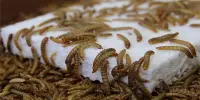Have you ever had the impression that someone has viewed a piece of media and simply… does not get it? Maybe they saw Total Recall and thought the moral was “hey, Mars would be a great place to implement indentured servitude,” or maybe they watched the entire Squid Game and thought to themselves, “it would be cool and good, in my opinion, and I assume everyone else’s, to spend thousands of dollars recreating this.” Well, it appears that people have (one again) identified too closely with The Matrix’s nightmarish robot masters.
Whereas most of us might think “eep” (or possibly “ohhh”) when we saw a vision of factory-farmed humanity anesthetized by virtual reality while their bodies were continually juiced for their masters’ profit, a group of dairy farmers apparently thought it looked very rad. “Virtual reality spectacles were installed to cows in Russia. zzet Koçak, a Turkish cow farmer and rancher, told Turkish news agency Anadolu Ajansi, “We decided to test it in our own business” (via Interesting Engineering). “We tested the virtual reality goggles on two of our animals in the first stage.” We kept track of the process for around ten days. In animals wearing the eyewear, we noticed an increase in both the quality and quantity of milk.”
According to Interesting Engineering, Koçak decided to adopt what we can term The Mootrix after his cows’ milk output began to suffer due to a lack of feed and hay. Koçak said he first tried playing classical music to the animals to counteract the effects of less fodder and more time inside, citing multiple studies indicating that happy cows produce more, better milk – until a chance, social media post alerted him to the sci-fi solution being trialed by farmers in Russia.
Koçak first strapped his two guinea-pig cows with a pair of VR headsets each. eager to put the concept to the test — and yes, there are images. Cows’ eyes are widely apart on either side of their heads because they are neither especially arboreal nor predatory, thus a standard VR gear would only cover one eye at most. Despite how strange and ethically dubious the idea may appear, it appears to be a success – at least in terms of milk production.
According to Koçak, the two cows that spend their days wandering through virtual green meadows produce around 27 liters (7 gallons) of milk every day, which is a significant increase above the 22-liter (5 gallons) average produced by his animals forced to face reality. In fact, according to Koçak, the study was so successful that he hopes to add 10 more of his animals to the simulation — this time with specially constructed cow headsets from Russia. “These spectacles are beneficial to the animals’ emotional well-being. He explained, “We saw that the animals are less disturbed… the quality and quantity of milk is growing.” “We also contacted the Russian business that manufactures the glasses.” If we are successful in all ten cows, we would most likely order spectacles from Russia for the entire herd.”
















